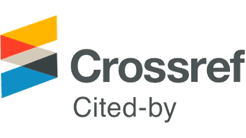About This Journal
Journal of Korea TAPPI (or ‘Palpuchongi Gisul’, abbr. ‘J. of Korea TAPPI, herein ‘KTAPPI’; ISSN: 0253-3200 ) was launched in 1969 to provides advance the scientific knowledge and to share the novel technologies in all related area of pulp, paper and biomass utilization. KTAPPI is published in English and Korean, bimonthly on the last day of even number months (February 28, April 30, June 30, August 30, October 30 and December 30), and indexed in ‘SCPOUS.
-
General
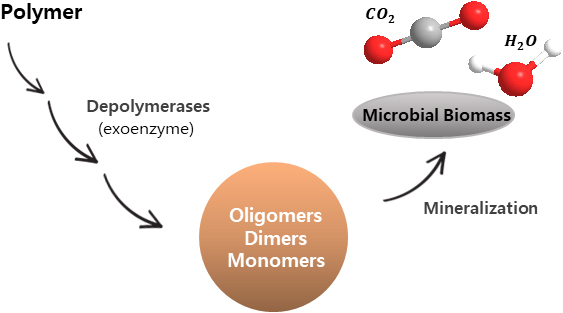
- A Review of Biodegradation Mechanisms and Evaluation Methods for Biobased Materials: Polysaccharides, Lignin, and Biopolyesters
- Soojin Kwon
- With increasing concerns over plastic waste, biobased materials have emerged as promising alternatives due to their renewable origin and potential biodegradability. However, …
- With increasing concerns over plastic waste, biobased materials have emerged as promising alternatives due to their renewable origin and potential biodegradability. However, biodegradation varies significantly depending on material composition, structural properties, and environmental conditions. This review explores the biodegradation characteristics of biobased materials, focusing on the key factors influencing their degradation processes. The discussion covers the general biodegradation mechanisms of biobased materials and the role of microbial and enzymatic activity. Structural properties such as crystallinity and polymer composition play a crucial role in determining degradation rates. Additionally, environmental factors, including temperature, moisture, and microbial communities, further impact biodegradability. A comprehensive understanding of these aspects is essential for optimizing material performance and sustainability. This review is expected to provide insights that support the development of biodegradable biobased materials for applications in packaging, textiles, and other sustainable industries. - COLLAPSE
-
Original Paper
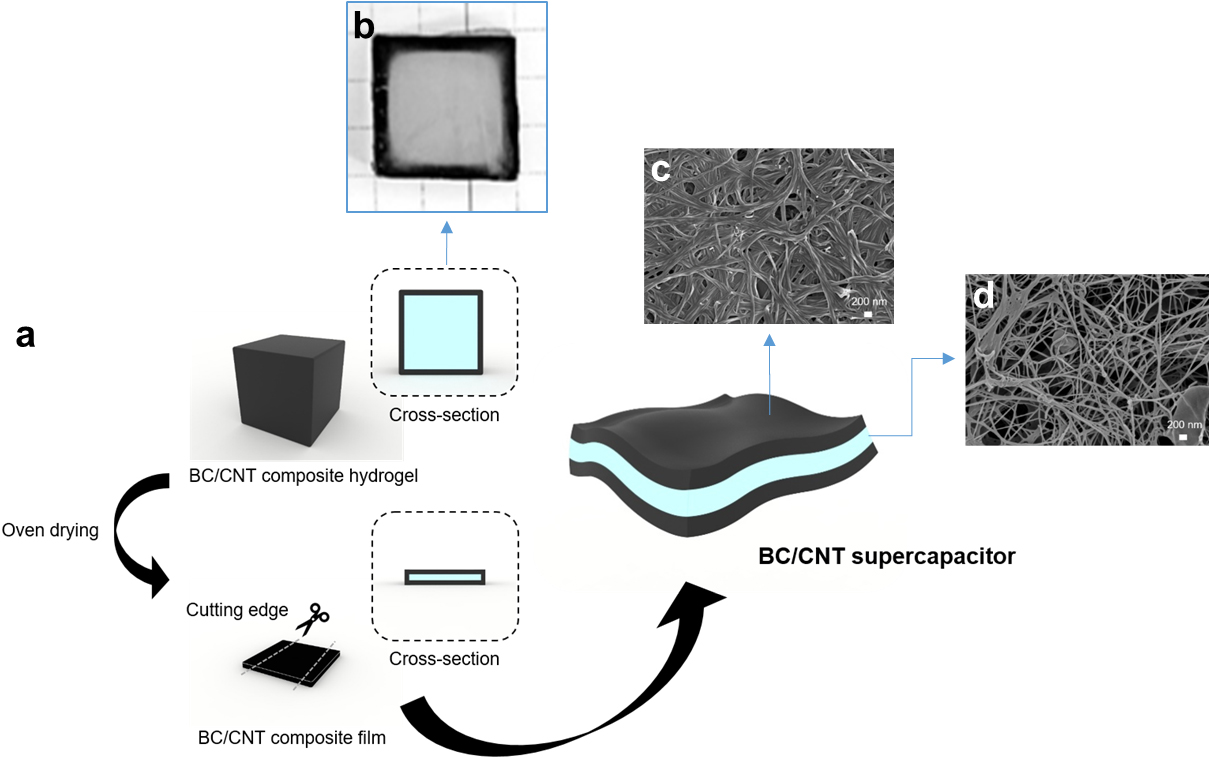
- Simple Fabrication of a Sandwiched Bacterial Cellulose/Carbon Nanotube Supercapacitor
- Dayeon Yoo, Jinho Hyun
- It describes the fabrication of a bacterial cellulose (BC)/carbon nanotube (CNT) composite using a simple diffusion method. The diffusion distance of CNT …
- It describes the fabrication of a bacterial cellulose (BC)/carbon nanotube (CNT) composite using a simple diffusion method. The diffusion distance of CNT to BC is influenced by the concentrations of CNT and hexadecyltrimethylammonium bromide (CTAB). Zeta potential of BC increases with the CTAB concentration, which facilitates the diffusion of CNT into the BC network by widening the space between BC fibers. The performance of the BC/CNT composites as a supercapacitor is demonstrated by electrochemical characterizations such as electrochemical impedance spectroscopy, cyclic voltammetry and galvanostatic charge-discharge measurements. - COLLAPSE
-
Original Paper
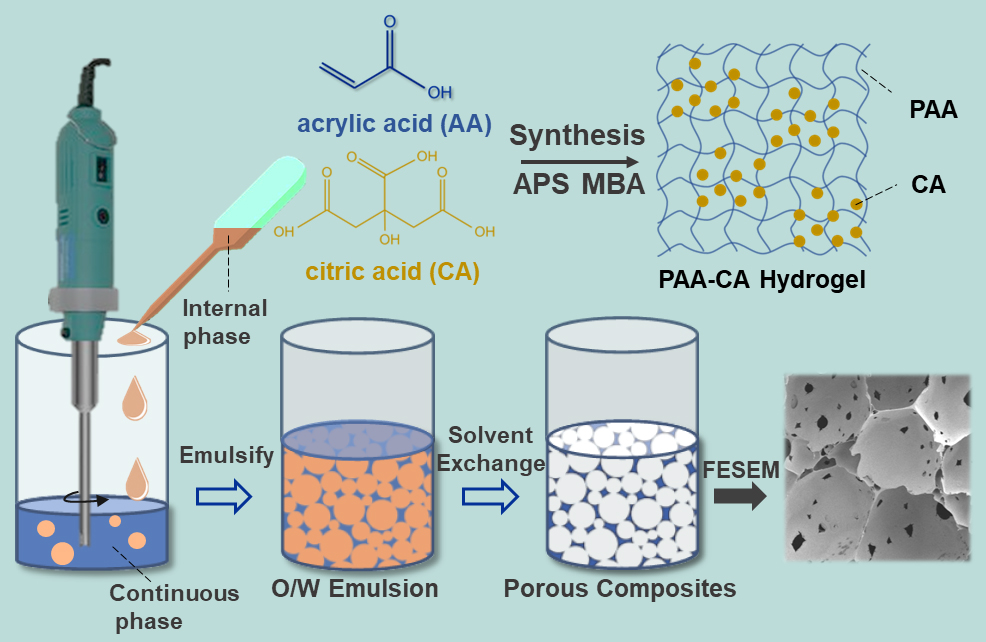
- Preparation of Biobased Porous Hydrogels by Citric Acid Grafted Polyacrylic Acid for Rare Earth Elements Separation
- Bo He, Wenchao Xiang, Wenjing Li, Ming He, Liangrong Yang, Chao Yang, Guihua Yang
- Rare earth elements (REEs) are essential for advanced technologies such as energy, electronics, and aerospace. Efficient separation of REEs is critical for …
- Rare earth elements (REEs) are essential for advanced technologies such as energy, electronics, and aerospace. Efficient separation of REEs is critical for the full utilization of natural limited resources. To obtain biobased absorbents with large adsorption capacity, high selectivity, and good reusability, a larger surface area and functionalized surface of absorbents are required. In this work, the porous PAA-CA (citric acid-grafted polyacrylic acid) hydrogels were prepared using a high internal phase emulsion templating method. The physical and chemical properties of PAA-CA were characterized by FTIR, XPS, and SEM. The influence of pH, temperature, initial concentration, and contact time on the adsorption capacity of Pr3+ (light REE) and Er3+ (heavy REE) was investigated and analyzed. The results show that PAA-CA hydrogels exhibited good adsorption performance with a better adsorption capacity for Er3+ of around 400 mg/g. The adsorption process was pH-dependent, with optimal adsorption at pH = 3–7. Kinetic studies revealed that the adsorption followed a pseudo-second-order model, while thermodynamic analyses confirmed the process was spontaneous and endothermic. PAA-CA exhibited good selectivity for Er3+ in a binary ion system, especially containing K+ or Fe3+. Furthermore, the hydrogels retained high adsorption capacities across 10 adsorption-desorption cycles, highlighting their excellent reusability. These results suggest that porous PAA-CA hydrogels are promising materials for the selective recovery of REEs from aqueous solutions. - COLLAPSE
-
Original Paper
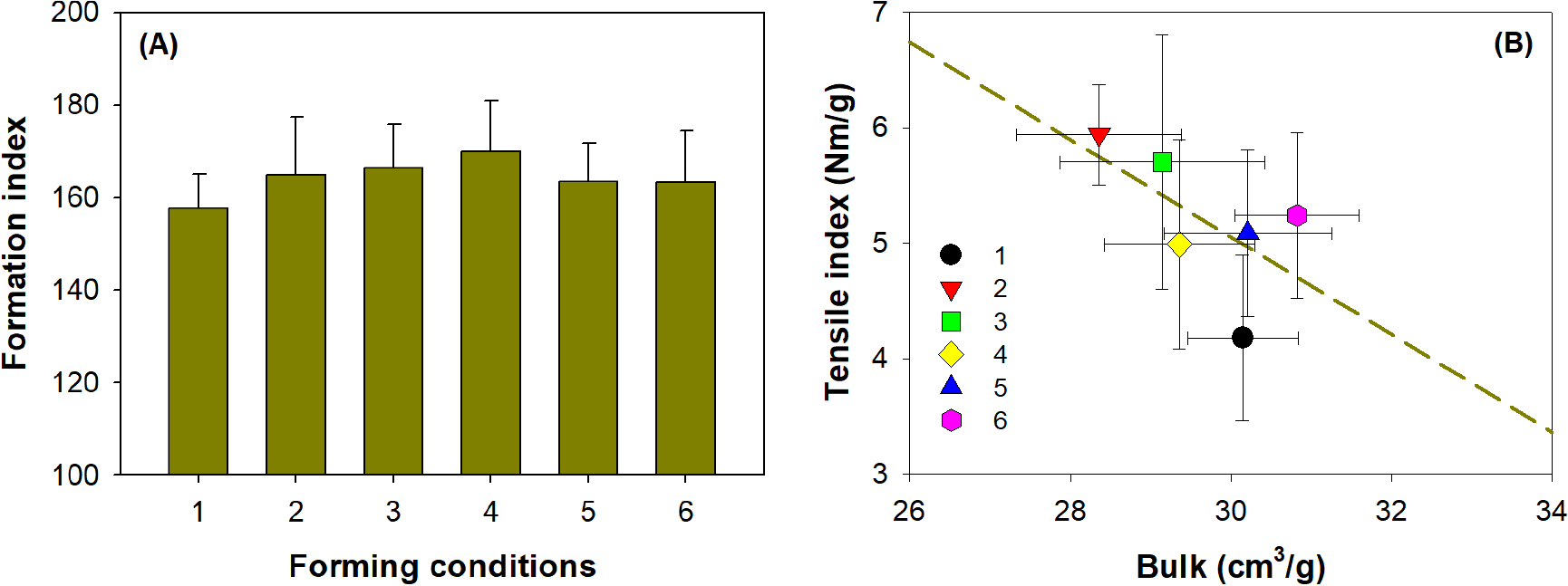
-
Effect of PVA-Boric Acid Strengthening Agents on the Properties of Foam-formed Sheets
PVA-붕산 지력증강제가 폼포밍 시트의 물성에 미치는 영향
-
Gwon-Hui Park, Byoung-Uk Cho
박권희, 조병욱
- Foam forming technology is a sheet or mold forming process that uses liquid foam instead of water, allowing for high consistency forming, …
- Foam forming technology is a sheet or mold forming process that uses liquid foam instead of water, allowing for high consistency forming, improved dewatering, enhanced formation, and the production of low density materials. However, foam-formed sheet generally has lower strength compared to water-based sheet. Therefore, to increase the applicability of foam forming technology, methods to improve sheet strength need to be developed. In this study, the effects of the chemical addition sequence of SDS, PVA, and crosslinkers, as well as the PVA-to-crosslinker ratio and the amount of PVA or PVA-boric acid on the physical properties of foam-formed sheets, were investigated. The results indicate that the optimum chemical addition sequence involves first generating fiber foam with SDS, followed by the sequential addition of PVA and borate. The most effective PVA-to-crosslinker ratio was determined to be 95:5, with boric acid selected as the optimal crosslinker. Increasing the dosage of PVA or PVA-boric acid resulted in an increase in bulk but a decrease in tensile strength in foam-formed sheets. However, the combination of PVA and boric acid improved tensile strength by 25–35% compared to PVA alone at the same dosage level. In addition, at equivalent bulk levels, the tensile strength of the PVA-boric acid system remained higher than that of PVA alone. These results suggest that the combined use of PVA and boric acid as strength additives can simultaneously improve the bulk and tensile strength of foam-formed sheets, enabling the development of low density materials with improved mechanical properties. - COLLAPSE
-
Effect of PVA-Boric Acid Strengthening Agents on the Properties of Foam-formed Sheets
-
Original Paper
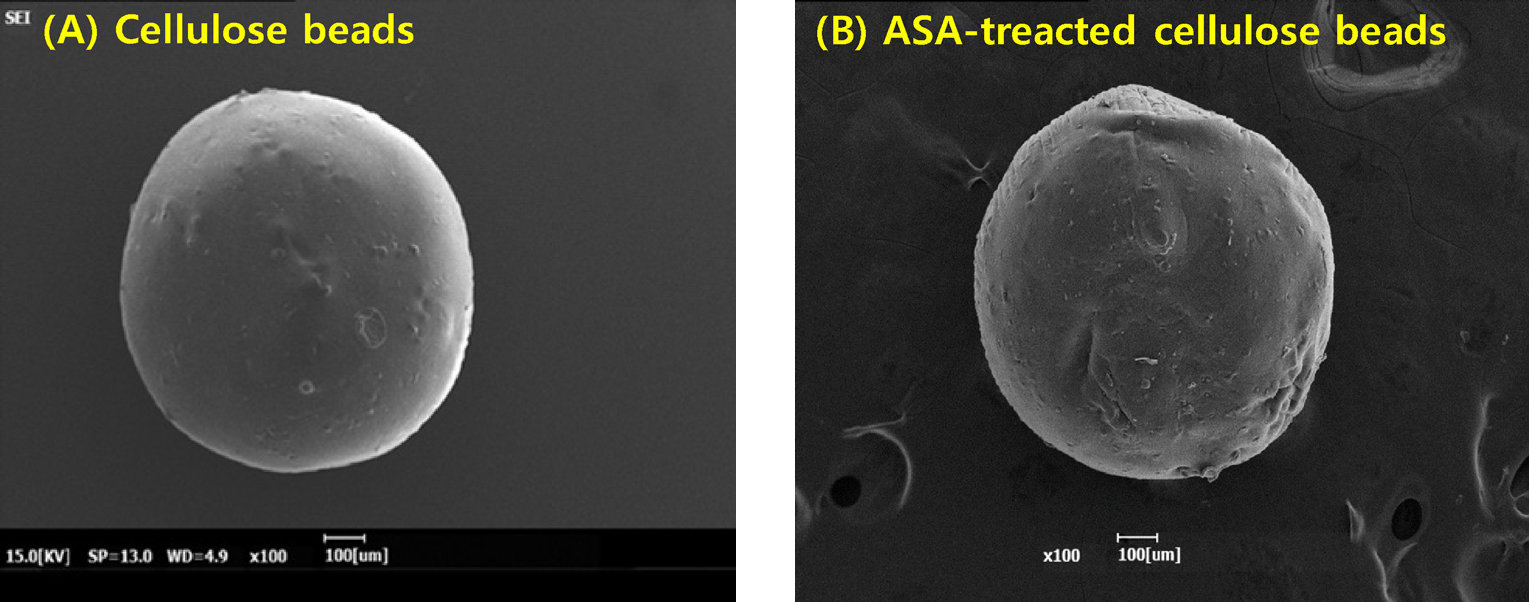
-
Enhancing the Hydrophobicity of Cellulose Beads through ASA Treatment
ASA 처리에 의한 셀룰로오스 비즈의 소수성 향상
-
Minseok Jang, Byoung-Uk Cho
장민석, 조병욱
- Hydrophobic cellulose beads were successfully prepared by immersing cellulose beads in an alkenyl succinic anhydride (ASA) solution for surface modification. The cellulose …
- Hydrophobic cellulose beads were successfully prepared by immersing cellulose beads in an alkenyl succinic anhydride (ASA) solution for surface modification. The cellulose beads were fabricated by dissolving hardwood bleached kraft pulp (HwBKP) in a tetraethylammonium hydroxide (TEAH)/urea solvent, followed by a dropping method to produce spherical structures. FT-IR analysis confirmed the formation of covalent ester bonds between ASA and cellulose, as evidenced by the disappearance of anhydride peaks and the appearance of new ester peaks. Compared to untreated cellulose beads, ASA-treated beads exhibited reduced water absorption capacity, while their oil absorption capacity was increased. Furthermore, the ASA-treated beads showed enhanced wet strength, as indicated by lower deformation under shear stress after swelling in water, indicating successful hydrophobic modification. These results suggest that ASA treatment by immersion is an effective approach for fabricating hydrophobic cellulose beads. - COLLAPSE
-
Enhancing the Hydrophobicity of Cellulose Beads through ASA Treatment
-
Original Paper
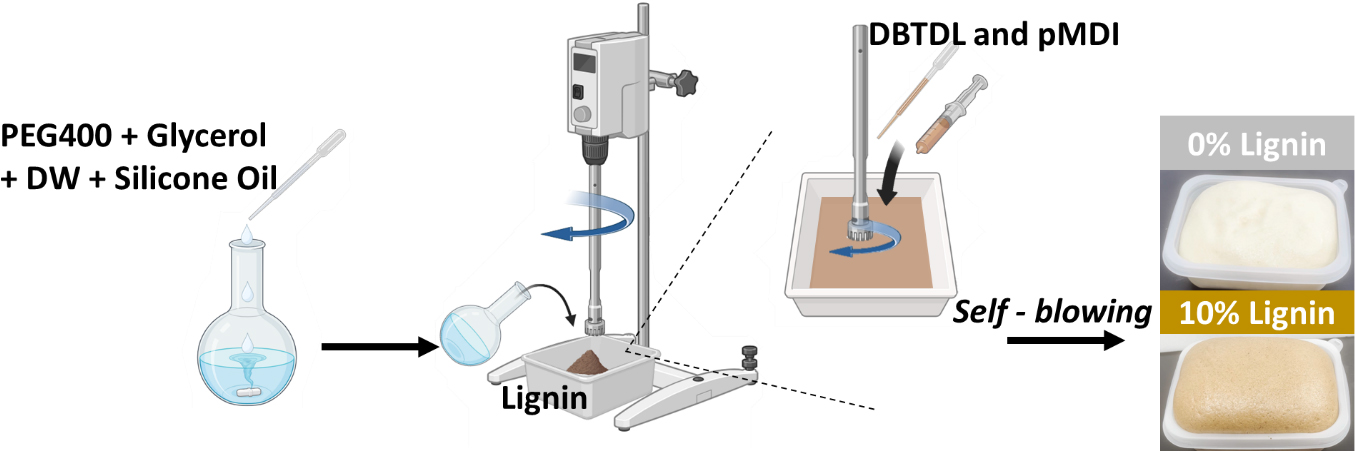
-
Effect of Lignin Polyol Incorporation on the Properties and Flame Retardancy of Polyurethane Foam
리그닌 폴리올 도입이 폴리우레탄 폼의 물성 및 난연성에 미치는 영향
-
Ji Won Heo, Won Hyeok Jang, Young Bin Cho, Si Hyeon Lim, Yong Sik Kim
허지원, 장원혁, 조영빈, 임시현, 김용식
- This study investigates the potential of lignin as a partial polyol replacement in polyurethane (PU) foam production and evaluates the impact of …
- This study investigates the potential of lignin as a partial polyol replacement in polyurethane (PU) foam production and evaluates the impact of varying lignin content on the foam’s physical and chemical properties. Lignin-based polyurethane (LPU) foam were successfully fabricated with different lignin contents, and FT-IR, XPS, and EA analyses confirmed the formation of urethane bonds between lignin and PU. As lignin content increased, the reactivity of the PU network changed, significantly impacting the foam’s properties. Contact angle measurements revealed that the higher the lignin content, the more hydrophobic the foam, indicating lignin’s role in enhancing the foam’s water resistance. Additionally, compressive strength improved as lignin content increased, suggesting lignin’s reinforcing effect within the PU matrix. The foam’s thermal stability and flame resistance were also positively affected, with higher lignin content enhancing flame-retardant performance. These results demonstrate that lignin is a promising sustainable polyol alternative, offering improved mechanical, thermal, and flame-retardant properties for PU foams. Furthermore, this study suggests that LPU foams with tunable properties can be applied in a wide range of fields, contributing to the development of more eco-friendly and functional materials. - COLLAPSE
-
Effect of Lignin Polyol Incorporation on the Properties and Flame Retardancy of Polyurethane Foam
-
Original Paper

-
Effects of Self-Organized Pore Formation Conditions on the Properties of Porous Cellulose Film
자기-조직적 공극 형성 조건이 셀룰로오스 기반 다공성 필름 특성에 미치는 영향
-
Min Ji Kim, Yun Yeong Kwak, Jin Ho Seo
김민지, 곽윤영, 서진호
- Porous membranes are widely used in separation, purification, biomedical applications, and biosensors, most of which are derived from petrochemical-based polymers. However, growing …
- Porous membranes are widely used in separation, purification, biomedical applications, and biosensors, most of which are derived from petrochemical-based polymers. However, growing concerns about environmental pollution have led to increased demand for the development of porous membranes from biomass-based, eco-friendly polymers. In this study, porous cellulose films were fabricated by blending cellulose acetate butyrate (CAB) with polyethylene glycol (PEG) using the Breath Figure self-assembly technique. The effects of CAB molecular weight and relative humidity on the pore structure and mechanical properties of the films were investigated. An increase in CAB molecular weight led to increased porosity, pore size, density, and tensile strength. Furthermore, higher relative humidity enhanced pore formation but led to a decrease in tensile strength. These results suggest that the pore size and distribution of the films can be effectively controlled by adjusting the CAB molecular weight and relative humidity using the Breath Figure self-assembly technique. - COLLAPSE
-
Effects of Self-Organized Pore Formation Conditions on the Properties of Porous Cellulose Film
-
Original Paper
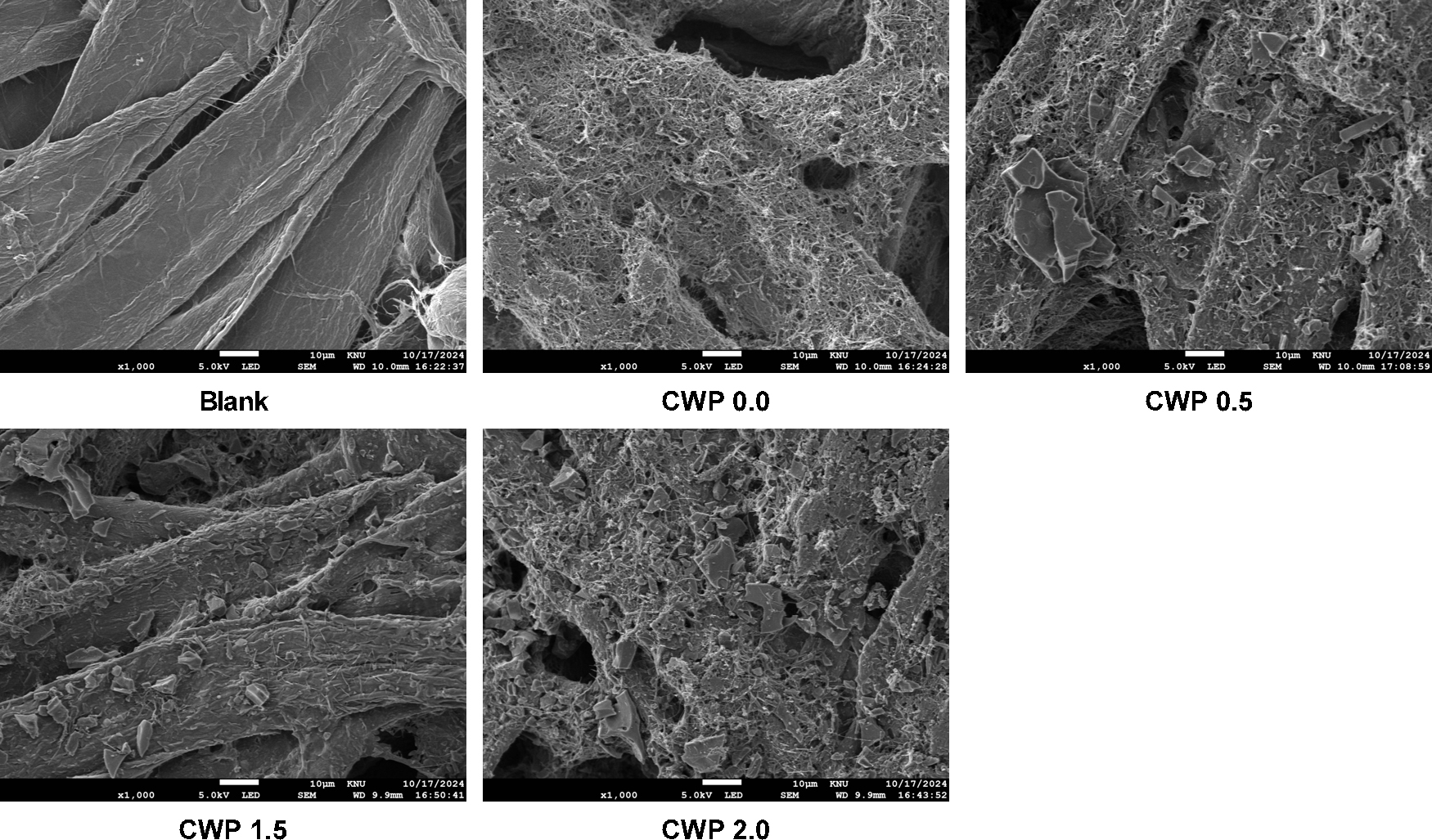
-
A Study on the Feasibility of Replacing Conductive Materials with Carbonized Wood
탄화목을 활용한 전도성 물질 대체 가능성 연구
-
Yun Yeong Kwak, Min Ji Kim, Jin Ho Seo
곽윤영, 김민지, 서진호
- The increasing incidence of wildfires has resulted in a substantial accumulation of wildfire-charred wood, most of which remains underutilized. This study investigated …
- The increasing incidence of wildfires has resulted in a substantial accumulation of wildfire-charred wood, most of which remains underutilized. This study investigated the potential of carbonized wood as a conductive material by fabricating conductive paper using wood carbonized at 1,000°C for 1 hour and multi-walled carbon nanotubes (MWCNTs). FE-SEM analysis showed that a higher content of charred wood resulted in irregular particle formation, disrupting the MWCNT network. FT-IR analysis confirmed modifications in functional groups, while surface resistance measurements showed increased electrical resistance and reduced electrical conductivity with higher charred wood content. However, additional dip coating cycles improved electrical conductivity by improving material contacts and electron transport pathways. These results indicate that wildfire-charred wood is a promising candidate for conductive applications and provide valuable insights into optimizing material composition for improved performance. - COLLAPSE
-
A Study on the Feasibility of Replacing Conductive Materials with Carbonized Wood



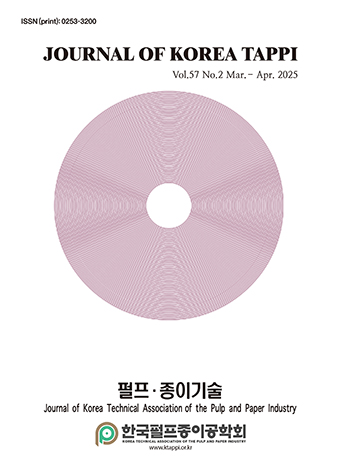 Journal of Korea TAPPI
Journal of Korea TAPPI




